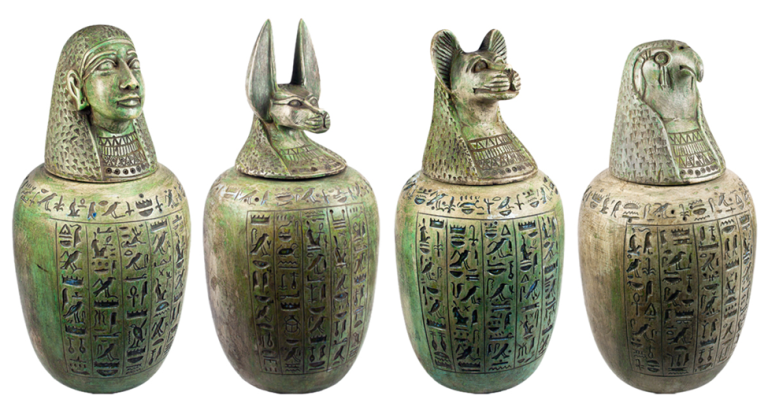
I’ve been thinking a lot these days about my heart. I want to do all I can to keep in pumping for a few more years. I did find it interesting that when the Egyptians came to that all important sacred ceremony of mummification, the heart was not involved.
The canopic jars were four in number, each for the safekeeping of particular human organs: the stomach, intestines, lungs, and liver, all of which, it was believed, would be needed in the afterlife. There was no jar for the heart: the Egyptians believed it to be the seat of the soul, and so it was left inside the body.
The Egyptians viewed the heart as the seat of intellect and emotion; as such, it played a central role in the rebirth of an individual in the afterlife. The heart of the individual was weighed against the feather representing the goddess of truth, Ma’at, in a judgment process overseen by Osiris, the lord of the underworld. The judgment was a frequent subject for funerary art, especially on papyri and coffins. Central to the scene was a large balance, with the heart in one pan and either a feather or a tiny figure of Ma’at, in the other pan. In most scenes, a demon called Ammit, “the Devourer,” crouches below the balance, anxiously awaiting the outcome.
Should the heart of the deceased prove to be heavy with wrongdoing, it would be eaten by the demon, and the hope of an afterlife vanished. Oddly enough, the Egyptians never seem to have depicted the negative outcome of the weighing, only the joyful individual being received by Osiris and presented with offerings.
It was crucial that the heart remain with the body during the mummification process, in order to be present for the judgment. A protective amulet or heart scarab was typically wrapped with the mummy, in case the heart should be damaged or removed. Such amulets were frequently inscribed with a spell to prevent the heart from bearing false witness against the deceased before Osiris.
I love Leonardo da Vinci’s quote: “Tears come from the heart and not the brain.”
Or as Confucius said: “Wherever you go. . .go with all your heart!”
If you want to use the photo it would also be good to check with the artist beforehand in case it is subject to copyright. Best wishes. Aaren Reggis Sela
Thank you for the observation. I try to pay all of the royalty fees on Pinterest and Google, but thank you for the suggestion.
You have noted very interesting points! ps nice site. Sarine Wilburt Sadira
Nice answer back in return of this difficulty with firm arguments and describing everything about that. Ester Hallsy Jedd